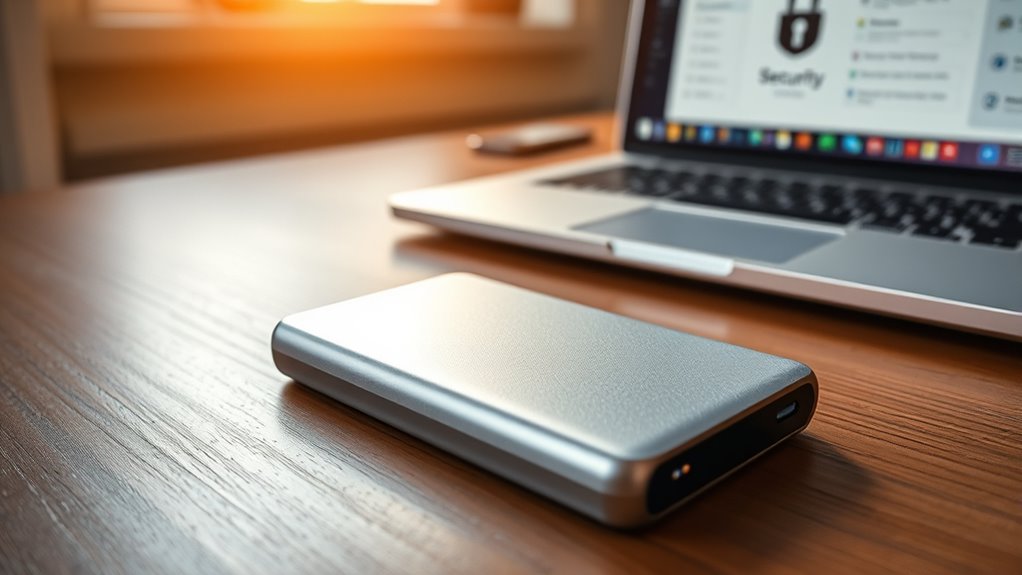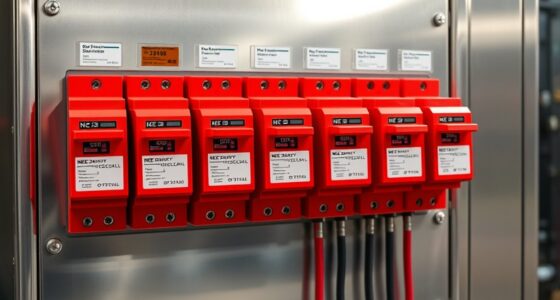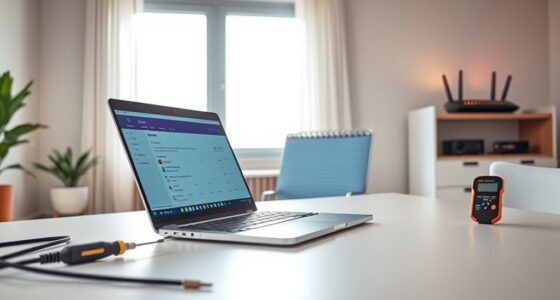To encrypt an external SSD for cross-platform use, choose versatile tools like VeraCrypt or verify your drive is formatted with widely supported file systems like exFAT. Use VeraCrypt for full encryption across Windows, macOS, and Linux, and consider BitLocker or FileVault on compatible systems. Remember to back up data first and store passwords securely. If you keep exploring, you’ll discover detailed steps to make your encrypted drive accessible and secure on all your devices.
Key Takeaways
- Choose cross-platform encryption tools like VeraCrypt to ensure compatibility across Windows, macOS, and Linux.
- Format the external SSD with a universally supported file system such as exFAT for seamless read/write access.
- Backup data before encryption and verify drive recognition on all intended OSes prior to use.
- Use strong, unique passwords and store recovery keys securely for consistent multi-OS access.
- Keep encryption software and drive firmware updated to maintain security and compatibility across platforms.
Choosing the Right Encryption Tool for Cross-Platform Compatibility
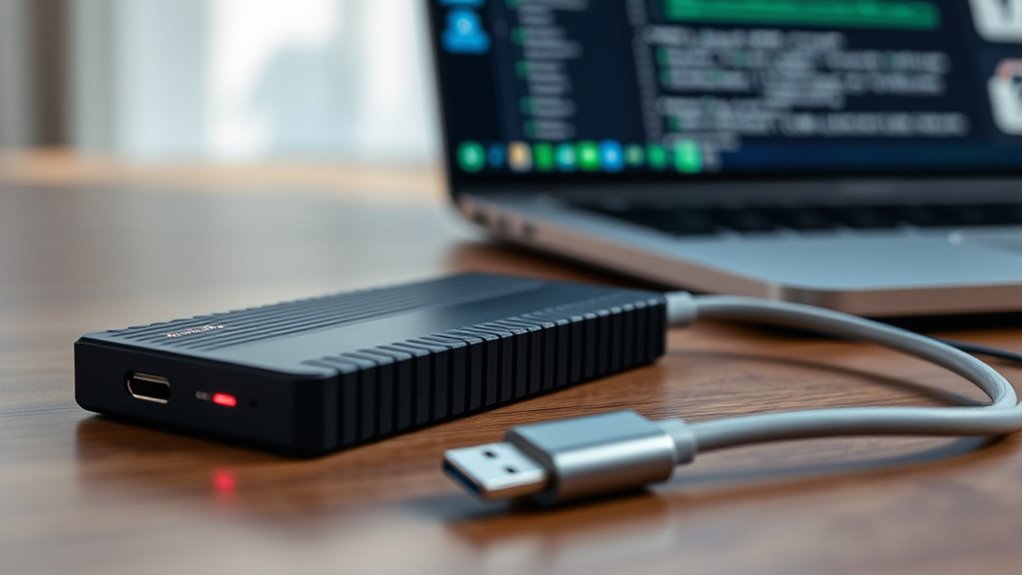
When selecting an encryption tool for your external SSD, it is vital to prioritize cross-platform compatibility so you can access your data seamlessly across different devices. Look for tools that support Windows, macOS, and Linux, ensuring you won’t face issues when switching between systems. Open-source options like VeraCrypt are popular because they work across multiple platforms and are trusted for security. Avoid proprietary software that limits compatibility or requires specific OS versions. Also, consider whether the encryption method is compatible with your workflow and if it offers easy-to-use interfaces. Compatibility isn’t just about reading and writing data; it’s about maintaining security without sacrificing ease of access. Choosing the right tool upfront saves you time and hassle later when you need reliable, cross-platform encryption. Encryption standards are crucial to ensure your data remains protected regardless of the operating system you use.
Preparing Your External SSD for Encryption
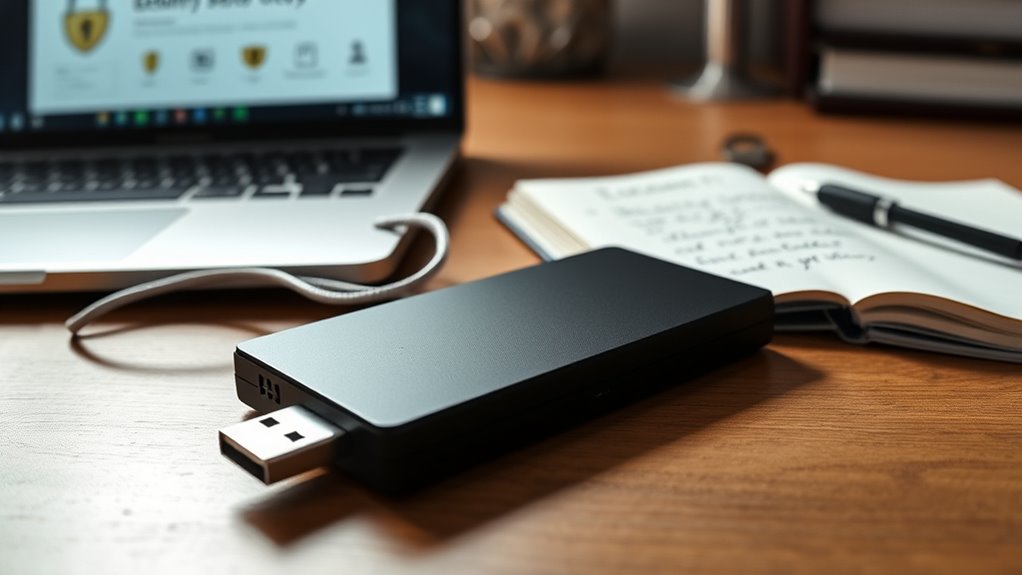
Before encrypting your external SSD, making certain to prepare it properly guarantees a smooth and secure process. Start by backing up any important data, as encryption may erase existing files. Next, check that the drive has sufficient free space—at least double the size of the data you plan to encrypt—to prevent issues during the process. Ensure the drive is formatted with a compatible file system, like exFAT or NTFS, depending on your operating systems. If necessary, reformat the drive, but only after backing up. Remove any unnecessary files to streamline encryption. Finally, verify that your external SSD is properly connected and recognized by your computer. Proper preparation minimizes errors and guarantees a secure, efficient encryption process. Additionally, understanding Forsale 100 options can help you choose the right tools or software for encryption.
Encrypting With Veracrypt: Step-By-Step Guide
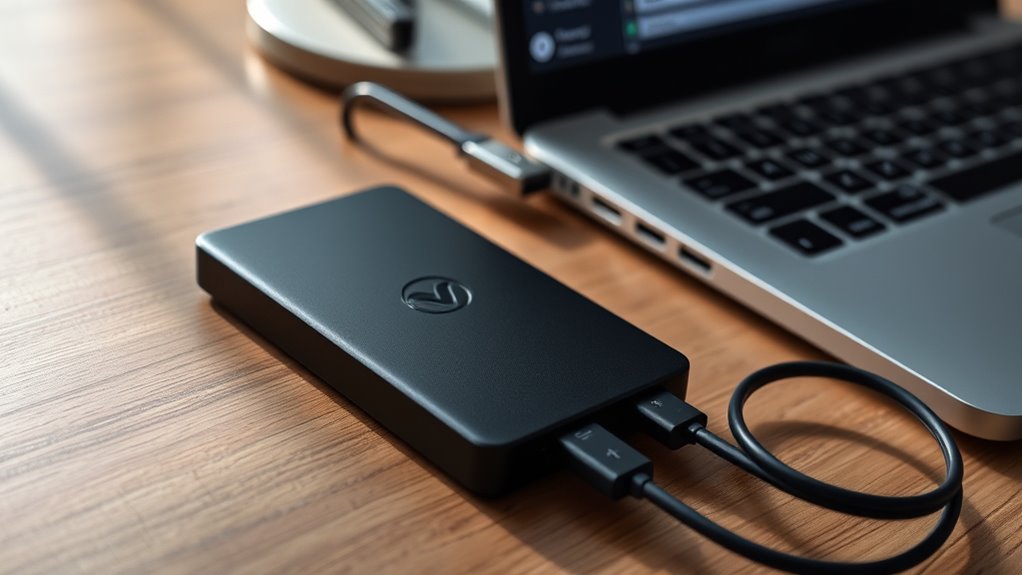
To start encrypting your external SSD with VeraCrypt, you’ll first need to download and install the software from its official website. Once installed, open VeraCrypt and click “Create Volume.” Choose “Encrypt a non-system partition/drive,” then select your external SSD from the list. Proceed with the default encryption options or customize as needed. Set a strong password when prompted. During the process, VeraCrypt will format and encrypt your drive, making it secure and unreadable without the password. Additionally, understanding the importance of contrast ratio can help you evaluate how well the encrypted drive displays data visually, especially when used in different environments. Here’s a visual to guide you:
| Step | Description |
|---|---|
| Download & Install | Get VeraCrypt from its official site and install it. |
| Create Volume | Launch VeraCrypt, select “Create Volume” option. |
| Select Drive | Pick your external SSD from the list. |
| Set Password & Encrypt | Choose a strong password, then start encryption. |
Using BitLocker for Windows Compatibility
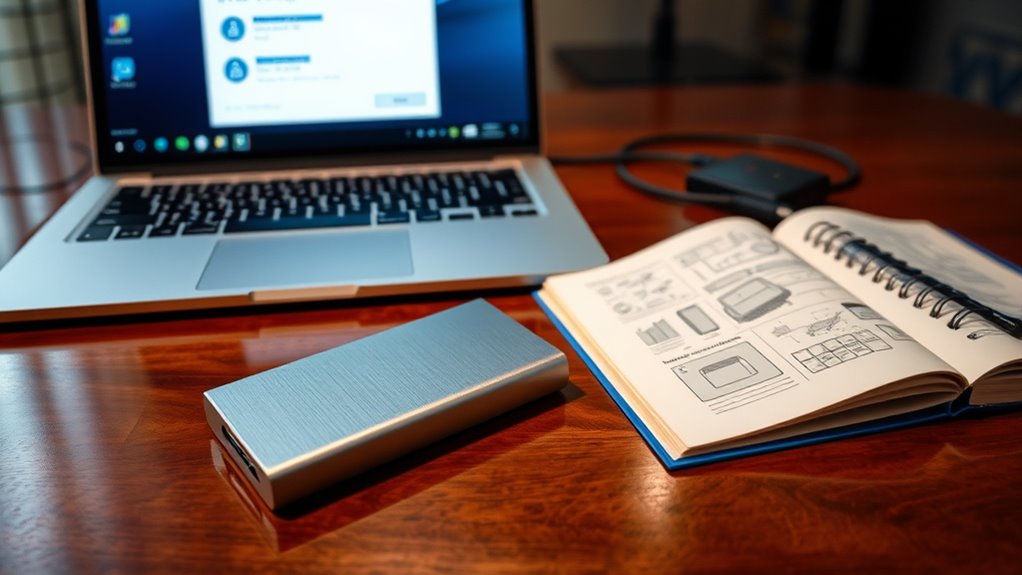
Using BitLocker makes securing your external SSD straightforward and reliable. You’ll find the setup process simple, even if you’re new to encryption tools. Once enabled, your data stays protected and compatible with Windows systems effortlessly. Environmental considerations should also be taken into account to ensure your data handling aligns with best practices.
Secure Data With Bitlocker
Wondering how to keep your external SSD secure and easily accessible on Windows? BitLocker offers a straightforward solution. It encrypts your drive, protecting your data from unauthorized access if lost or stolen. To enable BitLocker, connect your SSD, open File Explorer, right-click the drive, and select “Turn on BitLocker.” You’ll then choose a password or PIN and save your recovery key in a safe location. Once activated, your data remains protected without impacting your daily use. BitLocker uses strong encryption standards, ensuring your files are secure. It’s seamlessly integrated into Windows, making it easy to manage encryption settings and monitor drive status. By securing your external SSD with BitLocker, you ensure your sensitive information stays private, even if the drive falls into the wrong hands.
Easy Setup Process
Enabling BitLocker on your external SSD is a straightforward process that seamlessly integrates with Windows. First, connect your drive and open the Control Panel. Navigate to “System and Security” and select “BitLocker Drive Encryption.” Find your external SSD in the list and click “Turn on BitLocker.” You’ll be prompted to choose how to unveil the drive—either with a password or a smart card. Select your preferred option, then create a strong password or PIN. Next, save the recovery key somewhere safe—either to your Microsoft account, a file, or print it out. Confirm your settings, and click “Start Encrypting.” The process runs in the background, and once complete, your drive is securely encrypted with minimal effort. Additionally, understanding electric horsepower can help you gauge the performance levels of various devices and tools.
Encrypting on Macos With Filevault and Third-Party Apps
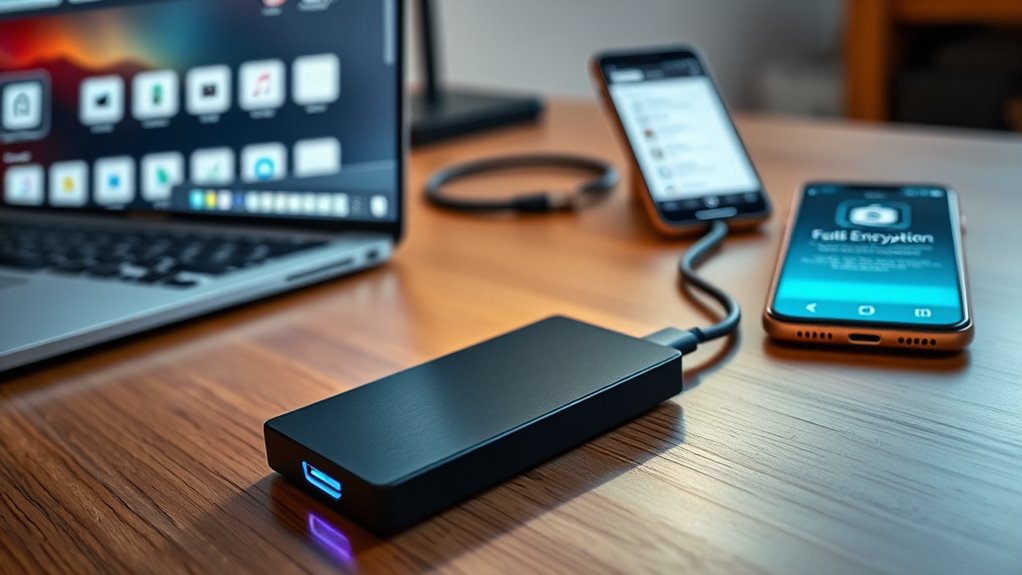
On macOS, encrypting an external SSD can be straightforward with built-in tools like FileVault or through third-party applications. With FileVault, you can enable disk encryption seamlessly via Disk Utility or System Preferences. Third-party apps like VeraCrypt offer additional flexibility for cross-platform compatibility. Imagine your external drive as a secure vault, with options to lock it tightly or add extra layers of security. Utilizing encryption software ensures your data remains protected across different operating systems and devices.
Cross-Platform Encryption With Linux Tools Like LUKS
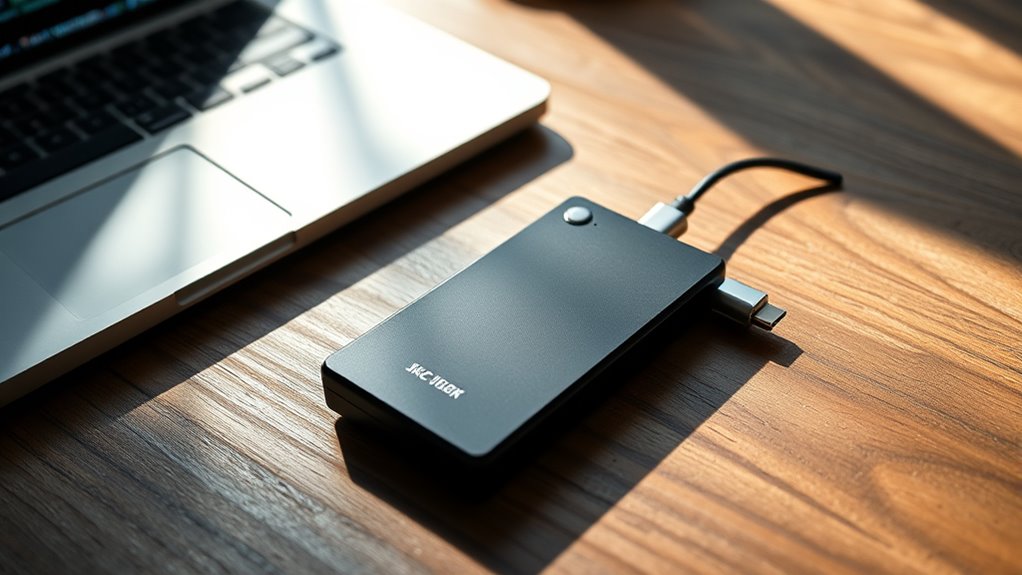
While macOS offers built-in encryption options like FileVault, Linux users need a different approach for securing external drives across platforms. LUKS (Linux Unified Key Setup) is a popular choice, providing robust full-disk encryption compatible with Linux systems. To use LUKS, you’ll need to format your external SSD with the cryptsetup utility. This process involves creating an encrypted container, setting a strong passphrase, and then opening the volume each time you connect the drive. While LUKS is powerful and flexible, it’s primarily designed for Linux, so accessing the encrypted drive on other operating systems requires additional tools or workarounds. Self Watering Plant Pots Nonetheless, for Linux users seeking cross-platform security, LUKS offers a reliable, open-source solution to safeguard sensitive data.
Managing and Accessing Encrypted Data on Different Operating Systems
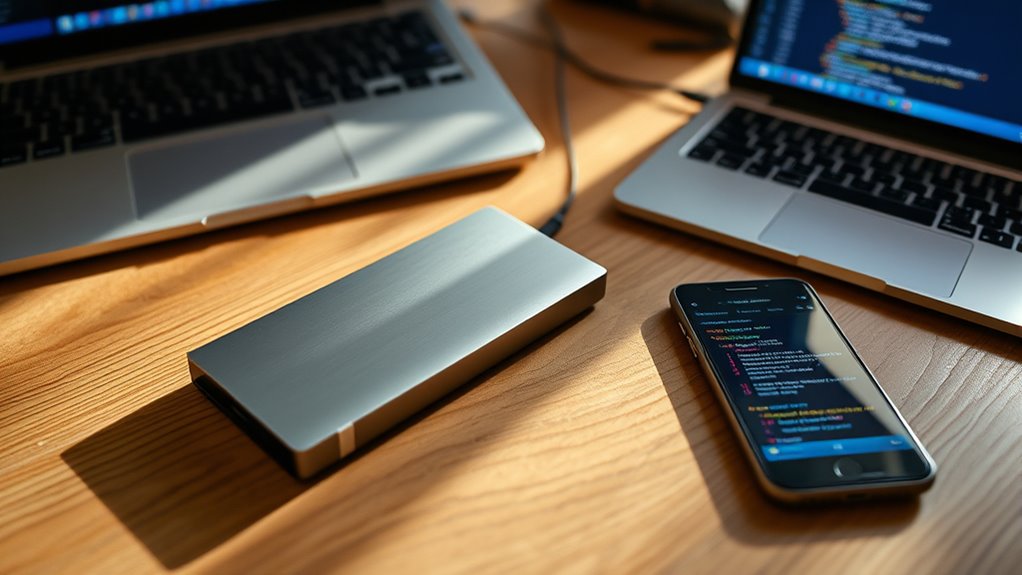
You need to access your encrypted data across different operating systems without safeguarding security. Compatibility can be tricky, but using the right tools ensures you can read and write safely. Let’s explore how to manage and access your encrypted external SSD on various platforms effectively. Incorporating robust data privacy measures is essential to protect sensitive information during cross-platform access.
Cross-Platform Encryption Compatibility
Ensuring your encrypted external SSD remains accessible across different operating systems requires careful consideration of compatibility. Not all encryption methods work seamlessly on Windows, macOS, and Linux. To avoid accessibility issues, choose encryption tools that support cross-platform compatibility, like VeraCrypt. VeraCrypt offers strong encryption with support for Windows, macOS, and Linux, making it ideal for shared drives. Additionally, consider file system formats that are compatible with multiple OSes, such as exFAT, which allows read and write access without additional software. Keep in mind that some encryption algorithms may require specific software or drivers on certain operating systems. Testing your setup on each platform before relying on it ensures you won’t encounter unexpected access problems later. This approach guarantees consistent access without sacrificing security.
Accessing Data Safely
Managing and accessing encrypted data across different operating systems can be straightforward if you understand the proper procedures. First, verify you have compatible encryption tools or software for each OS, like VeraCrypt or native built-in options. When connecting your external SSD, always unlock the drive with the correct password or key, and confirm the drive mounts properly. Avoid disconnecting or powering off the drive during data transfer to prevent corruption. If you switch between systems, double-check that encryption keys or credentials are accessible. Keep backups of your encryption keys or passwords in a secure location. This way, you can access your data safely without risking data loss or exposure. Additionally, understanding security vulnerabilities associated with new payment technologies can help you implement better safeguards for your encrypted data. Staying consistent and cautious helps guarantee your encrypted data remains protected across all your devices.
Best Practices for Maintaining and Securing Your Encrypted External SSD
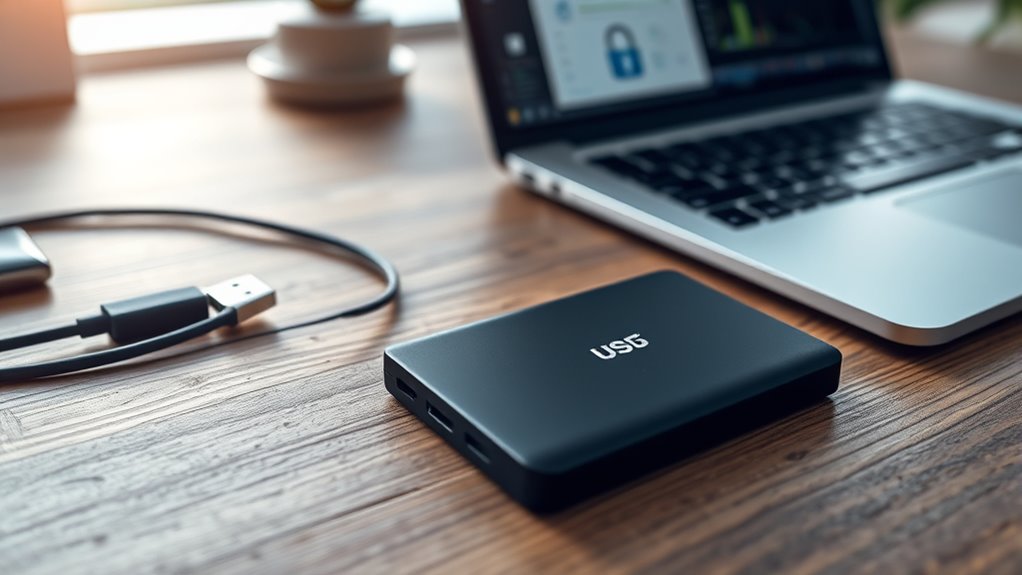
To keep your encrypted external SSD secure and functioning properly, adopting best practices for maintenance is essential. Regularly back up your data to a secure location, so you can recover it if the drive becomes corrupted or lost. Keep your firmware and encryption software up to date to patch vulnerabilities and improve performance. Avoid disconnecting the drive abruptly; always eject it safely to prevent data corruption. Store your encryption password or recovery key in a secure, separate location—never leave it on the drive itself. Use strong, unique passwords, and consider multi-factor authentication if available. Periodically check the drive’s health using diagnostic tools. Additionally, understanding encryption mechanisms can help you better grasp how your data remains protected. By following these practices, you ensure your data stays protected and your external SSD remains reliable across platforms.
Frequently Asked Questions
Can I Encrypt an External SSD Without Losing Existing Data?
You can encrypt an external SSD without losing existing data if you use the right tools and follow proper steps. First, back up your data to prevent any accidental loss. Then, choose a compatible encryption method like VeraCrypt or BitLocker. These tools allow you to encrypt your drive in-place, preserving your files. Just make sure you follow the instructions carefully and verify the encryption after completion.
Is It Safe to Share Encrypted SSDS Between Different OS Platforms?
You’re wondering if sharing encrypted SSDs between different OS platforms is safe. The answer isn’t straightforward. Cross-platform compatibility can introduce vulnerabilities, especially if encryption methods differ or aren’t universally supported. You might think you’re secure, but lurking risks could expose your data. To truly protect yourself, confirm you use encryption standards compatible across all systems and keep your software updated. Otherwise, you might be risking more than you realize.
How Do I Recover Data if I Forget My Encryption Password?
If you forget your encryption password, recovering data can be challenging. You should check if you set up any recovery options or backup keys beforehand, as these can help you regain access. Avoid trying to brute-force the password, as it may lock you out permanently. If no backup exists, professional data recovery services might be able to help, but success isn’t guaranteed. Always keep your passwords and recovery info in a safe place.
Do Encryption Tools Affect SSD Performance or Lifespan?
Think of encryption tools as a sturdy lock on a treasure chest; they add security but can cause slight delays. While modern encryption minimally impacts SSD performance and lifespan, it might introduce a small performance dip during intensive tasks. Overall, the trade-off is worth it for the added security. Just make certain you choose efficient tools, and remember that proper management keeps your SSD healthy and your data safe.
Are There Free Cross-Platform Encryption Options With Strong Security?
You want to find free, cross-platform encryption options with strong security. VeraCrypt is an excellent choice, offering free, open-source encryption that works on Windows, macOS, and Linux. It provides robust protection without impacting your SSD’s performance or lifespan. With VeraCrypt, you can securely encrypt your external SSD and access your data across different operating systems, ensuring your files stay safe without any extra cost or compatibility worries.
Conclusion
By encrypting your external SSD with a cross-platform tool like VeraCrypt, you guarantee data security across Windows, Mac, and Linux. Did you know that over 60% of data breaches involve stolen or lost devices? Encrypting your drives greatly reduces this risk. Stay vigilant by choosing the right tool, keeping your software updated, and following best practices. Protect your data today—it’s the smartest move in today’s digital world.
